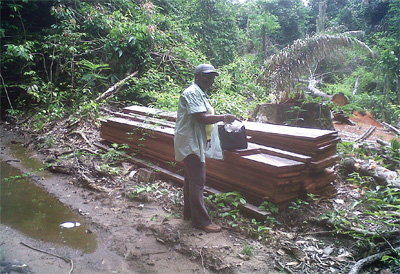Before the Road to Brazil (Part II)
(Reflections on Marronage & the Maroon Experience)
TO bring you this column every Sunday reflecting on my years living, researching and writing at Yukuriba Falls, on the Essequibo River, I’ve had to gather the courage to plunge head-first into depths of remembrances of those years before digital documentation by computer was possible; and had that even been possible, there was no electricity to facilitate it.  Most of the story is recorded on paper and stored in cartons and suitcases filled with…
Most of the story is recorded on paper and stored in cartons and suitcases filled with…
(recalling a time when this child found herself sucking away on a big one looking like a shining polished floor; I still have an aversion to roaches, dead or alive)
…will leave that story alone, ‘cause, yet again, am gagging; my stomach churning… Yours may be doing the same…. Documents in these boxes sprinkled with dead roaches, and moth balls are beginning to become confetti.
NIGHT VISITORS
Some of this work was digitised because I’d hired someone to come to my home every day, just to sit on my computer typing. But alas! One night, the thieves broke in; made off with both portable flash drive and laptop, along with my handbag with IDs and money. Two days later, my back-up hard-drive (mysteriously, I thought) crashed.
Were it not for these cartons and suitcases filled with the memory of the years at Yukuriba, those thieves would also have stolen (and I would, altogether, have lost) my mind.
That morning, standing there staring at the empty space on the dining table where my laptop rested last night, I defensively began the process of saving my mind; thinking…
Ideas can be stolen; but the best ideas are informed by boundless visions authentic creative minds alone would dare conjure;…is the odyssey of credible emancipated imagination “magically greased…free{d} from the locks and chains of definition” frolicking true…infinite as “the natural mystic”. Where in such a universe is there a market for creative plunder like this, I thought? Where would one go with stolen ideas? The charlatans who assume the role of custodians of our culture, never knowing the difference, will sell these ideas; will go on pronouncing on the worth of such creative fare, whether original or plagiarised and bastardised for disguise in the mass marketplace, but…
This thought leads me eagerly to this week’s ‘Letter From Yukuriba’, which is all about my reflections on the state of marronage in the 21st Century matrix.
OBSESSION
 For the greater part of the past 23 years of the Jagan/Jagdeo/Ramotar PPPC administration, I’ve been obsessed with the need to establish a ‘quilombo’ at Yukuriba Falls. A quilombo, from the Kimbundu word, kilombo, is a Brazilian hinterland settlement founded by Maroons, those runaway slaves who established independent communities and re-created African societies in a new environment.
For the greater part of the past 23 years of the Jagan/Jagdeo/Ramotar PPPC administration, I’ve been obsessed with the need to establish a ‘quilombo’ at Yukuriba Falls. A quilombo, from the Kimbundu word, kilombo, is a Brazilian hinterland settlement founded by Maroons, those runaway slaves who established independent communities and re-created African societies in a new environment.
For more than four centuries, these communities of Maroons existed wherever slave plantations were found in the Americas, from Brazil to Peru and the United States. With other names such as palenques, mocambos, cumbes, mambises or ladeiras, these new societies ranged from tiny bands that survived less than a year, to powerful states encompassing thousands of members that survived for generations and even centuries.
The Maroon culture survives still in independent communities in many parts of the world, including Suriname, French Guiana, Jamaica, Colombia and Belize.
PALMARES
Perhaps the most famous quilombo, Palmares is described as “a pre-nineteenth century phenomenon,” according to Wikepedia (if you want to take it from that source, which is sometimes apt to share misinformation).
“…no contemporary document calls Palmares a quilombo; instead, the term ‘mocambo’ is used. Palmares was home to not only escaped enslaved Africans, but also to mulattos, caboclos, Indians and poor whites, especially Portuguese trying to escape forced military service.”
The quilombos posed a serious threat to the Portuguese plantation; they provided sanctuary for maroons. Over two thousand of these rural Afro-Brazilian communities still exist in Brazil today.
I was influenced by those stimulating stories of Palmares, the ‘Negro Republic of Brazil’ in Pernambuco, and the most famous of the Brazilian quilombos.
For nearly the entire 17th Century, between 1672 and 1694, Palmares stood up to an average of one Portuguese expedition every fifteen months, and its impressive record of heroic accounts inspired the study of African History in modern Brazil. Thus, Palmares is significant in any study of both Brazilian and African history.
SEARCH FOR CLARITY
In my continuing search for clarity, I will be reviewing here with you today those years of being hounded; stalked; blocked and/or discouraged… Am recapturing the experience of the life that led to the spring of a discontent that awakened thoughts of marronage from the recent Plantation that was Guyana. (Incidentally, t’would be remiss if, for the historic record, I do not note here that even in these “more times”, it seems that the unrelenting plantation whip is still wielded by contemporary overseers. I can testify that this post-manumission abuse is far more painful; it inflicts deeper wounds on the mind of a Maroon than could ever have scarred the back of the enslaved… Am speaking for myself here.)
While searching for clarity, ideas that confluence with my muse on marronage, I stumbled onto some more food for thought; a philosophic (Joy James) treatise on ‘Afrarealism and the Black Matrix Maroon Philosophy at Democracy’s Border’.
“Five hundred years of flight from captivity into communal and conceptual wilderness, created the maroon philosophers’ natural habitat at the boundary of democracy… Through black radical feminist-womanist, queer theories, Afrarealism confronts theoretical limitations and political practices in conceptualizing freedom…
“Infrarealism recognises two coterminus phenomena: Democracy as a boundary, defining freedom through captivity, and Maroon philosophy at the borders reimagining freedom through flight.”
That then, in a goubi, ‘twas the necessity to essentially “re-image freedom through flight”… informing my passion to establish a quilombo at Yukuriba Falls; fuelling the preoccupation with the whole idea of sanctuary and peace through marronage; a quillombo, i.e., taking flight, for the sake of survival, from the contemporary plantation that was gathering energy in Guyana at the time.
In retrospect, I’ve acknowledged this compulsive drive as no less than an obsession which led me, at the turn of the century, to introduce myself to a conference of The 2000 Summer Institute Fellows in Washington DC, as: “A 20th Century Maroon escaping a 21st Century plantation”. This was immediately before making a presentation to teachers participating in the D.C. Area Writing Project co-ordinated by Howard University, D.C. Public Schools and the Network of Educators on the Americas.
I could never have guessed at the time, how very prophetic that introduction would turn out to be, even though I’d already begun to live the Maroon experience at Yukuriba Falls.




.jpg)










